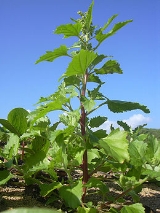
Chenopodium murale
Encyclopedia
Chenopodium murale is a species of plant in the amaranth family
known by the common names Nettle-leaved Goosefoot, Australian-spinach, salt-green, sowbane, Mauer-Gänsefuß (German), quenopódio (Brasil). This plant is native to Europe and parts of Asia and northern Africa, but it is widespread worldwide, particularly in tropical and subtropical areas due to its being easily introduced
. It is a common weed of fields and roadsides.
The inflorescence
s are powdery clusters of spherical buds. The buds do not open into typical flower blossoms but remain with the sepal
s covering the ovary
as the fruit develops.
Amaranthaceae
The flowering plant family Amaranthaceae, the Amaranth family, contains about 176 genera and 2,400 species.- Description :Most of these species are herbs or subshrubs; very few are trees or climbers. Some species are succulent....
known by the common names Nettle-leaved Goosefoot, Australian-spinach, salt-green, sowbane, Mauer-Gänsefuß (German), quenopódio (Brasil). This plant is native to Europe and parts of Asia and northern Africa, but it is widespread worldwide, particularly in tropical and subtropical areas due to its being easily introduced
Introduced species
An introduced species — or neozoon, alien, exotic, non-indigenous, or non-native species, or simply an introduction, is a species living outside its indigenous or native distributional range, and has arrived in an ecosystem or plant community by human activity, either deliberate or accidental...
. It is a common weed of fields and roadsides.
Description
This is an annual herb reaching 70 centimeters in height with an erect stem which is usually red or red-streaked green and leafy with green foliage. The oval to triangular leaves are toothed and broad, smooth on the upper surface and powdery on the undersides.The inflorescence
Inflorescence
An inflorescence is a group or cluster of flowers arranged on a stem that is composed of a main branch or a complicated arrangement of branches. Strictly, it is the part of the shoot of seed plants where flowers are formed and which is accordingly modified...
s are powdery clusters of spherical buds. The buds do not open into typical flower blossoms but remain with the sepal
Sepal
A sepal is a part of the flower of angiosperms . Collectively the sepals form the calyx, which is the outermost whorl of parts that form a flower. Usually green, sepals have the typical function of protecting the petals when the flower is in bud...
s covering the ovary
Gynoecium
Gynoecium is most commonly used as a collective term for all carpels in a flower. A carpel is the ovule and seed producing reproductive organ in flowering plants. Carpels are derived from ovule-bearing leaves which evolved to form a closed structure containing the ovules...
as the fruit develops.

